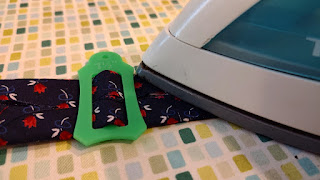Over the past week, I mended three towels. Two towels still had a lot of fluff. The other was simply beloved by my spouse, even though I would have cut it up to turn it into rags. Each towel was worn or ripped in a different way so I employed different mending techniques.
Adding a strip
The brown and white towel had a simple rip along the non terry cloth strip. I don't know if the strip has a name. I reinforced the torn area with some zig zag stitches and then cut a strip of velour from my stash, covered the strip and used a zig zag to stitch around the perimeter.
Blues Clues mend
The first blue towel has two serious tears on it. I pinned a thin scrap over the holes and then I went back and forth over the area using the darning foot to close them up. Then I cut out patches of blue velour and sewed them on each side the towel using a zig zag stitch around the perimeter. I used an over cast stitch on the edges to finish it off. The final product reminded me of Blues Clues.
Binding
The third towel had fraying edges. In the past I had stitched fraying edges with a zig zag, but the towels looked messy. I decided to bind this one. I used washed and preshrunk quilting fabric from my stash. I decided I didn't need bias binding because the towel didn't have curves, the fabric remnant selected was narrow and I didn't want to do the extra work to make bias tape.
I simply cut three inch strips along the grain and joined them with a quarter inch seam. I wanted to make a tape rather than using a double folded edge.
I folded the tape in half and pressed the fold. I then unfolded and used the bias tape guide I had to fold the edges into the middle. I ended up with single fold non-bias tape, a term I just made up!
Next, I unfolded the tape and pinned it wrong side up flush with the towel edge. I folded the end under at the beginning.
I stitched a little to the outside of the fold since the non-bias tape did not have the shorter edge like commercial tape. I used thread I wanted to use up even though it did not match. I stopped a quarter inch from each corner and took it off the machine to fold down the corner so they were mitered.
After I finished attaching the tape to the towel, I folded over the tape, pressed and stitched the opposite side as close to the edge as I could. I used matching thread so the stitching was less conspicuous. It's an old towel so you can see my stitching was not perfectly neat.
These mending techniques will help me keep these towels out of the landfill for a few more years.













%20v3.png)
%20v3.png)
